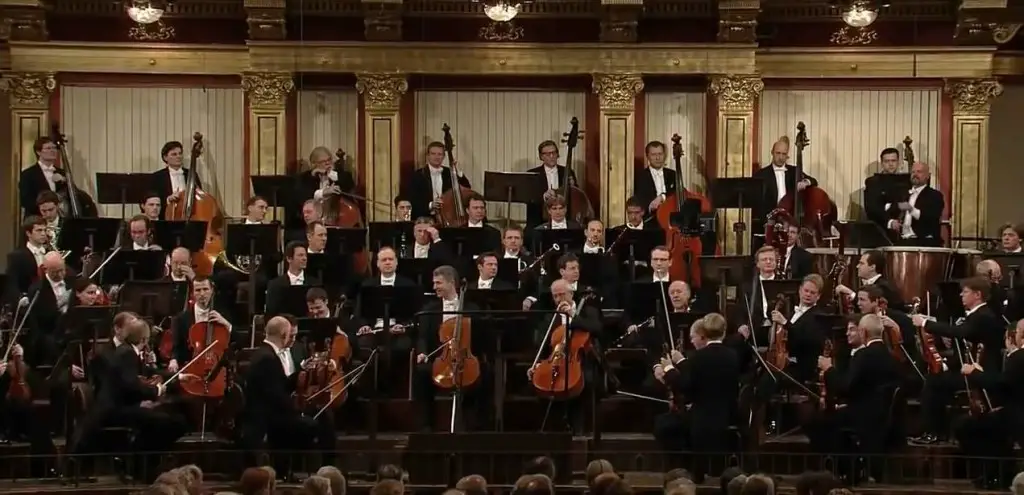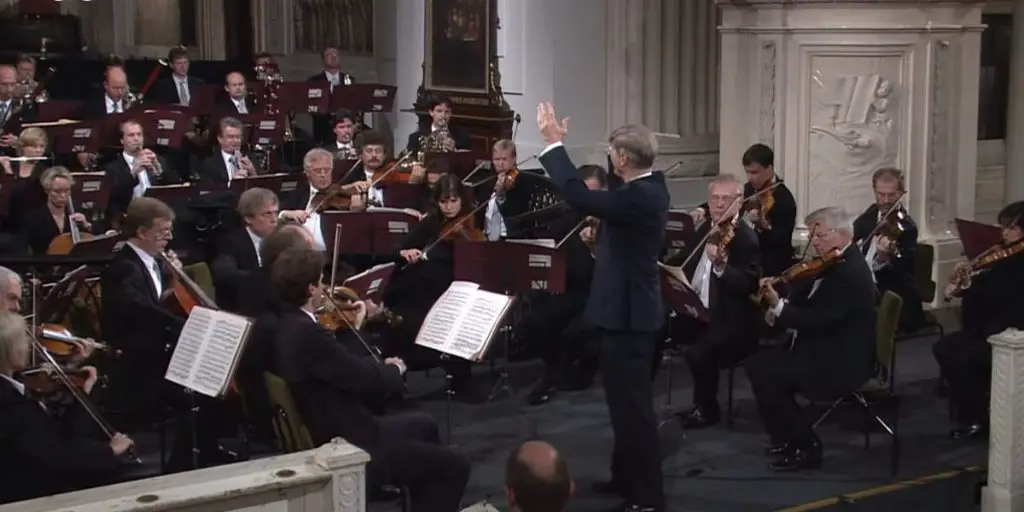Conducted by Gustavo Dudamel, the Orquesta Sinfónica Simón Bolívar de Venezuela performs Ludwig van Beethoven’s Symphony No. 5 in C minor, Op. 67. Recorded live at the Philharmonie de Paris in 2015.
Beethoven’s Symphony No. 5
Written between 1804 and 1808, during the most productive period of the composer’s career, Beethoven’s Symphony No. 5 is one of the best-known and most-loved compositions in classical music. Probably every human being on Earth at least once heard its distinctive four-note “short-short-short-long” motif – often interpreted as the musical manifestation of “fate knocking at the door”.
It did not immediately become the world’s (or even the composer’s) most famous symphony. During his lifetime, the Third “Eroica” was performed more often and the second movement of the Seventh (movements were often heard separately) was deemed “the crown of instrumental music.” But over the 19th century, the Fifth gradually came to epitomize Beethoven’s life and musical style.
The Fifth Symphony picked up further associations in the 20th century, be they of Allied victory during WWII or through its appearance in commercials and popular culture.
Movements
The symphony is scored for piccolo (fourth movement only), two flutes, two oboes, two clarinets in B♭ and C, two bassoons, contrabassoon or double bassoon (fourth movement only), two horns in E♭ and C, two trumpets, three trombones (alto, tenor, and bass, fourth movement only), timpani (in G-C) and strings.
There are four movements:
- Allegro con brio
- Andante con moto
- Scherzo. Allegro
- Allegro
1. Allegro con brio
The first movement of Beethoven’s Symphony No. 5 opens with the four-note motif, one of the most famous in Western music. It is in the traditional sonata form that Beethoven inherited from his classical predecessors, Haydn and Mozart (in which the main ideas that are introduced in the first few pages undergo elaborate development through many keys, with a dramatic return to the opening section – the recapitulation-about three-quarters of the way through).
It starts with two dramatic fortissimo phrases, the famous motif, commanding the listener’s attention. Following the first four bars, Beethoven uses imitations and sequences to expand the theme, these pithy imitations tumbling over each other with such rhythmic regularity that they appear to form a single, flowing melody. Shortly after, a very short fortissimo bridge, played by the horns, takes place before a second theme is introduced.
This second theme is in E♭ major, the relative major, and it is more lyrical, written piano, and features the four-note motif in the string accompaniment. The codetta is again based on the four-note motif. The development section follows, including the bridge. During the recapitulation, there is a brief solo passage for the oboe in a quasi-improvisatory style, and the movement ends with a massive coda.
There is considerable debate among conductors about the manner of playing the four opening bars. Some conductors take it in strict allegro tempo; others take the liberty of a weighty treatment, playing the motif in a much slower and more stately tempo; yet others take the motif molto ritardando (a pronounced slowing through each four-note phrase), arguing that the fermata over the fourth note justifies this. Some critics and musicians consider it crucial to convey the spirit of (pause) and-two-and one, as written, and consider the more common one-two-three-four to be misleading.
2. Andante con moto
The second movement of Beethoven’s Symphony No. 5, in A♭ major, the submediant major of the overall C minor key of the symphony, is a lyrical work in double variation form, which means that two themes are presented and varied in alternation. Following the variations, there is a long coda.
The movement opens with an announcement of its theme, a melody in unison by violas and cellos, with accompaniment by the double basses. A second theme soon follows, with a harmony provided by clarinets, bassoons, and violins, with a triplet arpeggio in the violas and bass. A variation of the first theme reasserts itself.
This is followed by a third theme, thirty-second notes in the violas and cellos with a counterphrase running in the flute, oboe, and bassoon. Following an interlude, the whole orchestra participates in a fortissimo, leading to a series of crescendos and a coda to close the movement.
3. Scherzo. Allegro
The third movement of Beethoven’s Symphony No. 5 is in ternary form, consisting of a scherzo and trio. It follows the traditional mold of Classical-era symphonic third movements, containing in sequence the main scherzo, a contrasting trio section, a return of the scherzo, and a coda. However, while the usual Classical symphonies employed a minuet and trio as their third movement, Beethoven chose to use the newer scherzo and trio form.
The movement returns to the opening key of C minor, played by the cellos and double basses. The opening theme is answered by a contrasting theme played by the winds, and this sequence is repeated. Then the horns loudly announce the main theme of the movement, and the music proceeds from there.
The trio section is in C major and is written in a contrapuntal texture. When the scherzo returns for the final time, it is performed by the strings pizzicato and very quietly. The third movement is also notable for its transition to the fourth movement, widely considered one of the greatest musical transitions of all time.
4. Allegro
The finale of Beethoven’s Symphony No. 5 begins without pause from the transition. The music resounds in C major, an unusual choice by the composer as a symphony that begins in C minor is expected to finish in that key. In Beethoven’s words:
Many assert that every minor piece must end in the minor. Neg Joy follows sorrow, sunshine-rain.
The triumphant and exhilarating finale is written in an unusual variant of sonata form: at the end of the development section, the music halts on a dominant cadence, played fortissimo, and the music continues after a pause with a quiet reprise of the “horn theme” of the scherzo movement. The recapitulation is then introduced by a crescendo coming out of the last bars of the interpolated scherzo section, just as the same music was introduced at the opening of the movement.
The Fifth Symphony finale includes a very long coda, in which the movement’s main themes are played in temporally compressed form. Towards the end, the tempo is increased to presto. The symphony ends with 29 bars of C major chords, played fortissimo. In The Classical Style, Charles Rosen suggests that this ending reflects Beethoven’s sense of Classical proportions: the “unbelievably long” pure C major cadence is needed “to ground the extreme tension of (this) immense work.”
It was shown recently that this long chord sequence was a pattern that Beethoven borrowed from the Italian composer Luigi Cherubini, whom Beethoven “esteemed the most” among his contemporary musicians. Spending much of his life in France, Cherubini employed this pattern consistently to close his overtures, which Beethoven knew well. The ending of his famous symphony repeats almost note by note and pause by pause the conclusion of Cherubini’s overture to his opera Eliza, composed in 1794 and presented in Vienna in 1803.
Sources
- Symphony No. 5 (Beethoven) on Wikipedia
- Symphony No. 5 in C Minor on Encyclopedia Britannica
- Notes on Beethoven’s Fifth Symphony on npr.org



